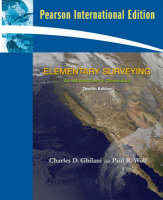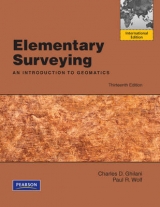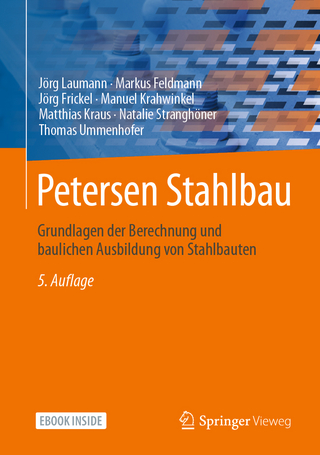
Elementary Surveying
Pearson (Verlag)
978-0-13-208307-2 (ISBN)
- Titel erscheint in neuer Auflage
- Artikel merken
This highly readable, best-selling text presents basic concepts and practical material in each of the areas fundamental to modern surveying (geomatics) practice. Its depth and breadth are ideal for self-study. The 12th Edition is updated throughout to reflect the latest advances and technology.
1 Introduction
¿ 1.1 Definition of Surveying
¿ 1.2 Geomatics
¿ 1.3 History of Surveying
¿ 1.4 Geodetic and Plane Surveys
¿ 1.5 Importance of Surveying
¿ 1.6 Specialized Types of Surveys
¿ 1.7 Surveying Safety
¿ 1.8 Land and Geographic Information Systems
¿ 1.9 Federal Surveying and Mapping Agencies
¿ 1.10 The Surveying Profession
¿ 1.11 Professional Surveying Organizations
¿ 1.12 Surveying on the Internet
¿ 1.13 Future Challenges in Surveying
Problems
Bibliography
2 Units, Significant Figures, and Field Notes
Part I ¿Units and Significant Figures
¿ 2.1 Introduction
¿ 2.2 Units of Measurement 25t
¿ 2.3 International System of Units (SI)
¿ 2.4 Significant Figures
¿ 2.5 Rounding Off Numbers
Part II ¿Field Notes
¿ 2.6 Field Notes
¿ 2.7 General Requirements of Handwritten Field Notes
¿ 2.8 Types of Field Books
¿ 2.9 Kinds of Notes
¿ 2.10 Arrangements of Notes
¿ 2.11 Suggestions for Recording Notes
¿ 2.12 Introduction to Data Collectors
¿ 2.13 Transfer of Files from Data Collectors
¿ 2.14 Digital Data File Management
¿ 2.15 Advantages and Disadvantages of Data Collectors
Problems
Bibliography
3 Theory of Errors in Observations
¿ 3.1 Introduction
¿ 3.2 Direct and Indirect Observations
¿ 3.3 Errors in Measurements
¿ 3.4 Mistakes
¿ 3.5 Sources of Errors in Making Observations
¿ 3.6 Types of Errors
¿ 3.7 Precision and Accuracy
¿ 3.8 Eliminating Mistakes and Systematic Errors
¿ 3.9 Probability
¿ 3.10 Most Probable Value
¿ 3.11 Residuals
¿ 3.12 Occurrence of Random Errors
¿ 3.13 General Laws of Probability
¿ 3.14 Measures of Precision
¿ 3.15 Interpretation of Standard Deviation
¿ 3.16 The 50, 90, and 95 Percent Errors
¿ 3.17 Error Propagation
3.17.1 Error of a Sum
3.17.2 Error of a Series
3.17.3 Error in a Product
3.17.4 Error in the Mean
¿ 3.18 Applications
¿ 3.19 Conditional Adjustment of Observations
¿ 3.20 Weights of Observations
¿ 3.21 Least-Squares Adjustment
Problems
Bibliography
4 Leveling–Theory, Methods, and Equipment
Part I ¿Leveling–Theory and Methods
¿ 4.1 Introduction
¿ 4.2 Definitions
¿ 4.3 North American Vertical Datum
¿ 4.4 Curvature and Refraction
¿ 4.5 Methods for Determining Differences in Elevation
4.5.1 Measuring Vertical Distances by Taping or Electronic Methods
4.5.2 Differential Leveling
4.5.3 Barometric Leveling
4.5.4 Trigonometric Leveling
Part II ¿Equipment for Differential Leveling
¿ 4.6 Categories of Levels
¿ 4.7 Telescopes
¿ 4.8 Level Vials
¿ 4.9 Tilting Levels
¿ 4.10 Automatic Levels
¿ 4.11 Digital Levels
¿ 4.12 Tripods
¿ 4.13 Hand Level
¿ 4.14 Level Rods
¿ 4.15 Testing and Adjusting Levels
4.15.1 Requirements for Testing and Adjusting Instruments
4.15.2 Adjusting for Parallax
4.15.3 Testing and Adjusting Level Vials
4.15.4 Preliminary Adjustment of the Horizontal Cross Hair
4.15.5 Testing and Adjusting the Line of Sight
Problems
Bibliography
5 Leveling—Field Procedures and Computations
¿ 5.1 Introduction
¿ 5.2 Carrying and Setting Up a Level
¿ 5.3 Duties of a Rodperson
¿ 5.4 Differential Leveling
¿ 5.5 Precision
¿ 5.6 Adjustments of Simple Level Circuits
¿ 5.7 Reciprocal Leveling
¿ 5.8 Three-Wire Leveling
¿ 5.9 Profile Leveling
5.9.1 Staking and Stationing the Reference Line
5.9.2 Field Procedures for Profile Leveling
5.9.3 Drawing and Using the Profile
¿ 5.10 Grid, Cross-Section, or Borrow-Pit Leveling
¿ 5.11 Use of the Hand Level
¿ 5.12 Sources of Error in Leveling
5.12.1 Instrumental Errors
5.12.2 Natural Errors
5.12.3 Personal Errors
¿ 5.13 Mistakes
¿ 5.14 Reducing Errors and Eliminating Mistakes
Problems
Bibliography
6 Distance Measurement
Part I ¿Methods for Measuring Distances
¿ 6.1 Introduction
¿ 6.2 Summary of Methods for Making Linear Measurements
¿ 6.3 Pacing
¿ 6.4 Odometer Readings
¿ 6.5 Optical Rangefinders
¿ 6.6 Tacheometry
¿ 6.7 Subtense Bar
Part II ¿Distance Measurements by Taping
¿ 6.8 Introduction to Taping
¿ 6.9 Taping Equipment and Accessories
¿ 6.10 Care of Taping Equipment
¿ 6.11 Taping on Level Ground
6.11.1 Lining In
6.11.2 Applying Tension
6.11.3 Plumbing
6.11.4 Marking Tape Lengths
6.11.5 Reading the Tape
6.11.6 Recording the Distance
¿ 6.12 Horizontal Measurements on Sloping Ground
¿ 6.13 Slope Measurements
¿ 6.14 Sources of Error in Taping
6.14.1 Incorrect Length of Tape
6.14.2 Temperature Other Than Standard
6.14.3 Inconsistent Pull
6.14.4 Sag
6.14.5 Tape Not Horizontal and Tape Off-Line
6.14.6 Improper Plumbing
6.14.7 Faulty Marking
6.14.8 Incorrect Reading or Interpolation
6.14.9 Summary of Effects of Taping Errors
¿ 6.15 Tape Problems
¿ 6.16 Combined Corrections in a Taping Problem
Part II ¿Electronic Distance Measurement
¿ 6.17 Introduction
¿ 6.18 Propagation of Electromagnetic Energy
¿ 6.19 Principles of Electronic Distance Measurement
¿ 6.20 Electro-Optical Instruments
¿ 6.21 Total Station Instruments
¿ 6.22 EDM Instruments Without Reflectors
¿ 6.23 Computing Horizontal Lengths From Slope Distances
6.23.1 Reduction of Short Lines by Elevation Differences
6.23.2 Reduction of Short Lines by Zenith or Altitude Angle
¿ 6.24 Errors in Electronic Distance Measurement
6.24.1 Personal Errors
6.24.2 Instrumental Errors
6.24.3 Natural Errors
Problems
Bibliography
7 Angles, Azimuths, and Bearings
¿ 7.1 Introduction
¿ 7.2 Units of Angle Measurement
¿ 7.3 Kinds of Horizontal Angles
¿ 7.4 Direction of a Line
¿ 7.5 Azimuths
¿ 7.6 Bearings
¿ 7.7 Comparison of Azimuths and Bearings
¿ 7.8 Computing Azimuths
¿ 7.9 Computing Bearings
¿ 7.10 The Compass and The Earth’s Magnetic Field
¿ 7.11 Magnetic Declination
¿ 7.12 Variations in Magnetic Declination
¿ 7.13 Software for Determining Magnetic Declination
¿ 7.14 Local Attraction
¿ 7.15 Typical Magnetic Declination Problems
¿ 7.16 Mistakes
Problems
Bibliography
8 Total Station Instruments: Angle Measurements
Part I ¿Total Station Instruments
¿ 8.1 Introduction
¿ 8.2 Characteristics of Total Station Instruments
¿ 8.3 Functions Performed by Total Station Instruments
¿ 8.4 Parts of a Total Station Instrument
¿ 8.5 Handling and Setting Up a Total Station Instrument
¿ 8.6 Servo-Driven and Remotely Operated Total Station Instruments
Part II ¿Angle Measurements
¿ 8.7 Relationship of Angles and Distances
¿ 8.8 Observing Horizontal Angles with Total Station Instruments
¿ 8.9 Observing Horizontal Angles by the Direction Method
¿ 8.10 Closing the Horizon
¿ 8.11 Observing Deflection Angles
¿ 8.12 Observing Azimuths
¿ 8.13 Observing Vertical Angles
¿ 8.14 Sights and Marks
¿ 8.15 Prolonging a Straight Line
¿ 8.16 Balancing-In
¿ 8.17 Random Traverse
¿ 8.18 Total Stations for Determining Elevation Differences
¿ 8.19 Adjustment of Total Station Instruments and Their Accessories
8.19.1 Adjustment of Plate-Level Vials
8.19.2 Adjustment of Tripods
8.19.3 Adjustment of Tribrachs
8.19.4 Adjustment of Optical Plummets
8.19.5 Adjustment of Circular Level Bubbles
¿ 8.20 Sources of Error in Total Station Work
8.20.1 Instrumental Errors
8.20.2 Natural Errors
8.20.3 Personal Errors
¿ 8.21 Propagation of Random Errors in Angle Observations
¿ 8.22 Mistakes
Problems
Bibliography
9 Traversing
¿ 9.1 Introduction
¿ 9.2 Observation of Traverse Angles or Directions
9.2.1 Traversing by Interior Angles
9.2.2 Traversing by Angles to the Right
9.2.3 Traversing by Deflection Angles
9.2.4 Traversing by Azimuths
¿ 9.3 Observation of Traverse Lengths
¿ 9.4 Selection of Traverse Stations
¿ 9.5 Referencing Traverse Stations
¿ 9.6 Traverse Field Notes
¿ 9.7 Angle Misclosure
¿ 9.8 Traversing with Total Station Instruments
¿ 9.9 Radial Traversing
¿ 9.10 Sources of Error in Traversing
¿ 9.11 Mistakes in Traversing
Problems
10 Traverse Computations
¿ 10.1 Introduction
¿ 10.2 Balancing Angles
¿ 10.3 Computation of Preliminary Azimuths or Bearings
¿ 10.4 Departures and Latitudes
¿ 10.5 Departure and Latitude Closure Conditions
¿ 10.6 Traverse Linear Misclosure and Relative Precision
¿ 10.7 Traverse Adjustment
10.7.1 Compass (Bowditch) Rule
10.7.2 Least-Squares Method
¿ 10.8 Rectangular Coordinates
¿ 10.9 Alternative Methods for Making Traverse Computations
10.9.1 Balancing Angles by Adjusting Azimuths or Bearings
10.9.2 Balancing Departures and Latitudes by Adjusting Coordinates
¿ 10.10 Lengths and Directions of Lines from Departures and Latitudes or Coordinates
¿ 10.11 Computing Final Adjusted Traverse Lengths and Directions
¿ 10.12 Coordinate Computations in Boundary Surveys
¿ 10.13 Use of Open Traverses
¿ 10.14 State Plane Coordinate Systems
¿ 10.15 Traverse Computations Using Computers
¿ 10.16 Locating Blunders in Traverse Measurements
¿ 10.17 Mistakes in Traverse Computations
Problems
Bibliography
11 Coordinate Geometry in Surveying Calculations
¿ 11.1 Introduction
¿ 11.2 Coordinate Forms of Equations for Lines and Circles
¿ 11.3 Perpendicular Distance from a Point to a Line
¿ 11.4 Intersection of Two Lines, Both Having Known Directions
¿ 11.5 Intersection of a Line with a Circle
¿ 11.6 Intersection of Two Circles
¿ 11.7 Three-Point Resection
¿ 11.8 Two-Dimensional Conformal Coordinate Transformation
¿ 11.9 Inaccessible Point Problem
¿ 11.10 Three-Dimensional Two-Point Resection
¿ 11.11 Conclusions
Problems
Bibliography
12 Area
¿ 12.1 Introduction
¿ 12.2 Methods of Measuring Area
¿ 12.3 Area by Division into Simple Figures
¿ 12.4 Area by Offsets from Straight Lines
12.4.1 Regularly Spaced Offsets
12.4.2 Irregularly Spaced Offsets
¿ 12.5 Area by Coordinates
¿ 12.6 Area by Double Meridian Distance Method
¿ 12.7 Area of Parcels with Circular Boundaries
¿ 12.8 Partitioning of Lands
12.8.1 Trial and Error Method
12.8.2 Use of Simple Geometric Figures
12.8.3 Coordinate Method
¿ 12.9 Area by Measurements from Maps
12.9.1 Area by Counting Coordinate Squares
12.9.2 Area by Scaled Lengths
12.9.3 Area by Digitizing Coordinates
12.9.4 Area by Planimeter
¿ 12.10 Sources of Error in Determining Areas
¿ 12.11 Mistakes in Determining Areas
Problems
Bibliography
13 The Global Positioning System–Introduction and Principles of Operation
¿ 13.1 Introduction
¿ 13.2 Overview of GPS
¿ 13.3 The GPS Signal
¿ 13.4 Reference Coordinate Systems for GPS
13.4.1 The Satellite Reference Coordinate System
13.4.2 The Geocentric Coordinate System
13.4.3 The Geodetic Coordinate System
¿ 13.5 Fundamentals of GPS Positioning
13.5.1 Code Ranging
13.5.2 Carrier Phase-Shift Measurements
¿ 13.6 Errors in GPS Observations
13.6.1 Clock Bias
13.6.2 Refraction
13.6.3 Other Error Sources
13.6.4 Geometry of Observed Satellites
13.6.5 Selective Availability
¿ 13.7 Differential GPS
¿ 13.8 Kinematic GPS Methods
¿ 13.9 Relative Positioning
13.9.1 Single Differencing
13.9.2 Double Differencing
13.9.3 Triple Differencing
¿ 13.10 Other Satellite Navigation Systems
13.10.1 The GLONASS Constellation
13.10.2 Galileo System
13.10.3 Compass
¿ 13.11 The Future
Problems
Bibliography
14 The Global Positioning System–Static surveys
¿ 14.1 Introduction
¿ 14.2 Field Procedures in GPS Surveys
14.2.1 Static Relative Positioning
14.2.2 Rapid Static Relative Positioning
14.2.3 Pseudokinematic Surveys
14.2.4 Kinematic Surveys
¿ 14.3 Planning GPS Surveys
14.3.1 Preliminary Considerations
14.3.2 Selecting the Appropriate Survey Method
14.3.3 Field Reconnaissance
14.3.4 Developing an Observation Scheme
14.3.5 Availability of Reference Stations
¿ 14.4 Performing Static GPS Surveys
¿ 14.5 Data Processing and Analysis
14.5.1 Specifications for GPS Surveys
14.5.2 Analysis of Fixed Baseline Measurements
14.5.3 Analysis of Repeat Baseline Measurements
14.5.4 Analysis of Loop Closures
14.5.5 Baseline Network Adjustment
14.5.6 The Survey Report
¿ 14.6 Sources of Errors in GPS Work
14.6.1 Instrumental Errors
14.6.2 Natural Errors
14.6.3 Personal Errors
¿ 14.7 Mistakes in GPS Work
¿ 14.8 Future Outlook for GPS
Problems
Bibliography
15 The Global Positioning System–Kinematic GPS
¿ 15.1 Introduction
¿ 15.2 Initialization
¿ 15.3 Equipment Used in Kinematic Surveys
¿ 15.4 Methods Used in Kinematic Surveys
¿ 15.5 Performing Post-Processed Kinematic Surveys
¿ 15.6 Communication in Real-Time Kinematic Surveys
¿ 15.7 Real-Time Networks
¿ 15.8 Performing Real-Time Kinematic Surveys
¿ 15.9 Machine Control
¿ 15.10 Errors in Kinematic Surveys
¿ 15.11 Mistakes in Kinematic Surveys
Problems
Bibliography
16 Adjustments by Least Squares
¿ 16.1 Introduction
¿ 16.2 Fundamental Condition of Least Squares
¿ 16.3 Least-Squares Adjustment by the Observation Equation Method
¿ 16.4 Matrix Methods in Least-Squares Adjustment
¿ 16.5 Matrix Equations for Precisions of Adjusted Quantities
¿ 16.6 Least-Squares Adjustment of Leveling Circuits
¿ 16.7 Propagation of Errors
¿ 16.8 Least-Squares Adjustment of GPS Baseline Vectors
¿ 16.9 Least-Squares Adjustment of Traditional Horizontal Plane Surveys
16.9.1 Linearizing Nonlinear Equations
16.9.2 The Distance Observation Equation
16.9.3 The Azimuth Observation Equation
16.9.4 The Angle Observation Equation
16.9.5 A Traverse Example Using WOLFPACK
¿ 16.10 Error Ellipses
¿ 16.11 Adjustment Procedures
¿ 16.12 Other Measures of Precision for Horizontal Stations
¿ 16.13 Conclusions
Problems
Bibliography
17 Mapping Surveys
¿ 17.1 Introduction
¿ 17.2 Basic Methods for Performing Mapping Surveys
¿ 17.3 Map Scale
¿ 17.4 Control for Mapping Surveys
¿ 17.5 Contours
¿ 17.6 Characteristics of Contours
¿ 17.7 Direct and Indirect Methods of Locating Contours
17.7.1 Direct Method
17.7.2 Indirect Method
¿ 17.8 Digital Elevation Models and Automated Contouring Systems
¿ 17.9 Basic Field Methods for Locating Topographic Details
17.9.1 Radiation by Total Station
17.9.2 Radiation by Stadia
17.9.3 Coordinate Squares or “Grid” Method
17.9.4 Offsets from a Reference Line
17.9.5 Topographic Detailing with GPS
17.9.6 Laser-Scanning
¿ 17.10 Three-Dimensional Conformal Coordinate Transformation
¿ 17.11 Selection of Field Method
¿ 17.12 Working with Data Collectors and Field-to-Finish Software
¿ 17.13 Hydrographic Surveys
17.13.1 Equipment for Making Soundings
17.13.2 Locating Soundings
17.13.3 Hydrographic Mapping
¿ 17.14 Sources of Error in Mapping Surveys
¿ 17.15 Mistakes in Mapping Surveys
Problems
Bibliography
18 Mapping
¿ 18.1 Introduction
¿ 18.2 Availability of Maps and Related Information
¿ 18.3 National Mapping Program
¿ 18.4 Accuracy Standards for Mapping
¿ 18.5 Manual and Computer-Aided Drafting Procedures
¿ 18.6 Map Design
¿ 18.7 Map Layout
¿ 18.8 Basic Map Plotting Procedures
18.8.1 Manually Plotting by Coordinates
18.8.2 Plotting Using CADD
¿ 18.9 Contour Interval
¿ 18.10 Plotting Contours
¿ 18.11 Lettering
¿ 18.12 Cartographic Map Elements
¿ 18.13 Drafting Materials
¿ 18.14 Automated Mapping and Computer-Aided Drafting Systems
¿ 18.15 Impacts of Modern Land and Geographic Information Systems on Mapping
¿ 18.16 Sources of Error in Mapping
¿ 18.17 Mistakes in Mapping
Problems
Bibliography
19 Control Surveys and Geodetic Reductions
¿ 19.1 Introduction
¿ 19.2 The Ellipsoid and Geoid
¿ 19.3 The Conventional Terrestrial Pole
¿ 19.4 Geodetic Position and Ellipsoidal Radii of Curvature
¿ 19.5 Geoid Undulation and Deflection of The Vertical
¿ 19.6 U.S. Reference Frames
19.6.1 North American Horizontal Datum of 1927 (NAD27)
19.6.2 North American Horizontal Datum of 1983 (NAD83)
19.6.3 Later Versions of NAD83
19.6.4 National Geodetic Vertical Datum of 1929 (NGVD29)
19.6.5 North American Vertical Datum of 1988 (NAVD88)
19.6.6 Transforming Coordinates between Reference Frames
¿ 19.7 Accuracy Standards and Specifications For Control Surveys
¿ 19.8 The National Spatial Reference System
¿ 19.9 Hierarchy of the National Horizontal Control Network
¿ 19.10 Hierarchy of the National Vertical Control Network
¿ 19.11 Control Point Descriptions
¿ 19.12 Field Procedures For Traditional Horizontal Control Surveys
19.12.1 Triangulation
19.12.2 Precise Traverse
19.12.3 Trilateration
19.12.4 Combined Networks
¿ 19.13 Field Procedures for Vertical Control Surveys
¿ 19.14 Reduction of Field Observations to Their Geodetic Values
19.14.1 Reduction of Distance Observations Using Elevations
19.14.2 Reduction of Distance Observations Using Vertical Angles
19.14.3 Reduction of Directions and Angles
19.14.4 Leveling and Orthometric Heights
¿ 19.15 Geodetic Position Computations
19.15.1 Direct Geodetic Problem
19.15.2 Inverse Geodetic Problem
¿ 19.16 The Local Geodetic Coordinate System
¿ 19.17 Three-Dimensional Coordinate Computations
¿ 19.18 Conclusions
Problems
Bibliography
20 State Plane Coordinates
¿ 20.1 Introduction
¿ 20.2 Projections Used in State Plane Coordinate Systems
¿ 20.3 Lambert Conformal Conic Projection
¿ 20.4 Transverse Mercator Projection
¿ 20.5 State Plane Coordinates in NAD27 and NAD83
¿ 20.6 Computing SPCS83 Coordinates in the Lambert Conformal Conic System
20.6.1 Zone Constants
20.6.2 The Direct Problem
20.6.3 The Inverse Problem
¿ 20.7 Computing SPCS83 Coordinates in the Transverse Mercator System
20.7.1 Zone Constants
20.7.2 The Direct Problem
20.7.2 The Inverse Problem
¿ 20.8 Reduction of Distances and Angles to State Plane Coordinate Grids
20.8.1 Grid Reduction of Distances
20.8.2 Grid Reduction of Azimuths and Angles
¿ 20.9 Computing State Plane Coordinates of Traverse Stations
¿ 20.10 Surveys Extending from One Zone to Another
¿ 20.11 Conversions between SPCS27 and SPCS83
¿ 20.12 The Universal Transverse Mercator Projection
¿ 20.13 Other Map Projections
20.13.1 Oblique Stereographic Map Projection
20.13.2 Oblique Mercator Map Projection
Problems
Bibliography
21 Boundary Surveys
¿ 21.1 Introduction
¿ 21.2 Categories of Land Surveys
¿ 21.3 Historical Perspectives
¿ 21.4 Property Description by Metes and Bounds
¿ 21.5 Property Description by Block and Lot System
¿ 21.6 Property Description by Coordinates
¿ 21.7 Retracement Surveys
¿ 21.8 Subdivision Surveys
¿ 21.9 Partitioning Land
¿ 21.10 Registration of Title
¿ 21.11 Adverse Possession and Easements
¿ 21.12 Condominium Surveys
¿ 21.13 Geographic and Land Information Systems
¿ 21.14 Sources of Error in Boundary Surveys
¿ 21.15 Mistakes
Problems
Bibliography
22 Surveys of the Public Lands
¿ 22.1 Introduction
¿ 22.2 Instructions for Surveys of the Public Lands
¿ 22.3 Initial Point
¿ 22.4 Principal Meridian
¿ 22.5 Baseline
¿ 22.6 Standard Parallels (Correction Lines)
¿ 22.7 Guide Meridians
¿ 22.8 Township Exteriors, Meridional (Range) Lines, and Latitudinal (Township) Lines
¿ 22.9 Designation of Townships
¿ 22.10 Subdivision of a Quadrangle Into Townships
¿ 22.11 Subdivision of a Township Into Sections
¿ 22.12 Subdivision of Sections
¿ 22.13 Fractional Sections
¿ 22.14 Notes
¿ 22.15 Outline of Subdivision Steps
¿ 22.16 Marking Corners
¿ 22.17 Witness Corners
¿ 22.18 Meander Corners
¿ 22.19 Lost and Obliterated Corners
¿ 22.20 Accuracy of Public Lands Surveys
¿ 22.21 Descriptions by Township Section and Smaller Subdivision
¿ 22.22 BLM Land Information System
¿ 22.23 Sources of Error
¿ 22.24 Mistakes
Problems
Bibliography
23 Construction Surveys
¿ 23.1 Introduction
¿ 23.2 Specialized Equipment for Construction Surveys
23.2.1 Visible Laser-Beam Instruments
23.2.2 Reflectorless Total Stations
¿ 23.3 Horizontal and Vertical Control
¿ 23.4 Staking Out A Pipeline
¿ 23.5 Staking Pipeline Grades
¿ 23.6 Staking Out a Building
¿ 23.7 Staking Out Highways
¿ 23.8 Other Construction Surveys
¿ 23.9 Construction Surveys Using Total Station Instruments
¿ 23.10 Construction Surveys Using GPS Equipment
¿ 23.11 Machine Control
¿ 23.12 As-Built Surveys with Laser Scanning
¿ 23.13 Sources of Error in Construction Surveys
¿ 23.14 Mistakes
Problems
Bibliography
24 Horizontal Curves
¿ 24.1 Introduction
¿ 24.2 Degree of Circular Curve
¿ 24.3 Definitions and Derivation of Circular Curve Formulas
¿ 24.4 Circular Curve Stationing
¿ 24.5 General Procedure of Circular Curve Layout by Deflection Angles
¿ 24.6 Computing Deflection Angles and Chords
¿ 24.7 Notes for Circular Curve Layout by Deflection Angles and Incremental Chords
¿ 24.8 Detailed Procedures for Circular Curve Layout by Deflection Angles and Incremental Chords
¿ 24.9 Setups on Curve
¿ 24.10 Metric Circular Curves by Deflection Angles and Incremental Chords
¿ 24.11 Circular Curve Layout by Deflection Angles and Total Chords
¿ 24.12 Computation of Coordinates on a Circular Curve
¿ 24.13 Circular Curve Layout by Coordinates
¿ 24.14 Curve Stakeout Using GPS and Robotic Total Stations
¿ 24.15 Circular Curve Layout by Offsets
¿ 24.16 Special Circular Curve Problems
24.16.1 Passing a Circular Curve through a Fixed Point
24.16.2 Intersection of a Circular Curve and a Straight Line
24.16.3 Intersection of Two Circular Curves
¿ 24.17 Compound and Reverse Curves
¿ 24.18 Sight Distance on Horizontal Curves
¿ 24.19 Spirals
24.19.1 Spiral Geometry
24.19.2 Spiral Calculation and Layout
¿ 24.20 Computation of “As-Built” Circular Alignments
¿ 24.21 Sources of Error in Laying Out Circular Curves
¿ 24.22 Mistakes
Problems
Bibliography
25 Vertical Curves
¿ 25.1 Introduction
¿ 25.2 General Equation of a Vertical Parabolic Curve
¿ 25.3 Equation of an Equal Tangent Vertical Parabolic Curve
¿ 25.4 High or Low Point on a Vertical Curve
¿ 25.5 Vertical Curve Computations Using the Tangent Offset Equation
25.5.1 Example Computations Using the English System of Units
25.5.2 Example Computations Using the Metric System
¿ 25.6 Equal Tangent Property of a Parabola
¿ 25.7 Curve Computations by Proportion
¿ 25.8 Staking a Vertical Parabolic Curve
¿ 25.9 Machine Control in Grading Operations
¿ 25.10 Computations for an Unequal Tangent Vertical Curve
¿ 25.11 Designing a Curve to Pass through a Fixed Point
¿ 25.12 Sight Distance
¿ 25.13 Sources of Error in Laying Out Vertical Curves
¿ 25.14 Mistakes
Problems
Bibliography
26 Volumes
¿ 26.1 Introduction
¿ 26.2 Methods of Volume Measurement
¿ 26.3 The Cross-Section Method
¿ 26.4 Types of Cross Sections
¿ 26.5 Average End Area Formula
¿ 26.6 Determining End Areas
26.6.1 End Areas by Simple Figures
26.6.2 End Areas by Coordinates
¿ 26.7 Computing Slope Intercepts
¿ 26.8 Prismoidal Formula
¿ 26.9 Volume Computations
¿ 26.10 Unit-Area, or Borrow-Pit, Method
¿ 26.11 Contour-Area Method
¿ 26.12 Measuring Volumes of Water Discharge
¿ 26.13 Sources of Error in Determining Volumes
¿ 26.14 Mistakes
Problems
Bibliography
27 Photogrammetry
¿ 27.1 Introduction
¿ 27.2 Uses of Photogrammetry
¿ 27.3 Aerial Cameras
¿ 27.4 Types of Aerial Photographs
¿ 27.5 Vertical Aerial Photographs
¿ 27.6 Scale of a Vertical Photograph
¿ 27.7 Ground Coordinates from a Single Vertical Photograph
¿ 27.8 Relief Displacement on a Vertical Photograph
¿ 27.9 Flying Height of a Vertical Photograph
¿ 27.10 Stereoscopic Parallax
¿ 27.11 Stereoscopic Viewing
¿ 27.12 Stereoscopic Measurement of Parallax
¿ 27.13 Analytical Photogrammetry
¿ 27.14 Stereoscopic Plotting Instruments
27.14.1 Direct Optical Projection Stereoplotters
27.14.2 Mechanical Projection Stereoplotters
27.14.3 Analytical Stereoplotters
27.14.4 Softcopy Stereoplotters
¿ 27.15 Orthophotos
¿ 27.16 Ground Control for Photogrammetry
¿ 27.17 Flight Planning
¿ 27.19 Airborne Laser-Mapping Systems
¿ 27.20 Remote Sensing
¿ 27.21 Sources of Error in Photogrammetry
¿ 27.22 Mistakes
Problems
Bibliography
28 Introduction to Geographic Information Systems
¿ 28.1 Introduction
¿ 28.2 Land Information Systems
¿ 28.3 GIS Data Sources and Classifications
¿ 28.4 Spatial Data
28.4.1 Simple Spatial Objects
28.4.2 Vector and Raster Formats
28.4.3 Topology
¿ 28.5 Nonspatial Data
¿ 28.6 Data Format Conversions
28.6.1 Vector-to-Raster Conversion
28.6.2 Raster-to-Vector Conversion
¿ 28.7 Creating GIS Databases
28.7.1 Generating Digital Data from Field Surveys
28.7.2 Digitizing from Aerial Photos with Stereoplotters
28.7.3 Digitizing Existing Graphic Materials
29.7.4 Keyboard Entry
29.7.5 Existing Digital Data Sets
29.7.6 Scanning
¿ 28.8 Metadata
¿ 28.9 GIS Analytical Functions
28.9.1 Proximity Analysis
28.9.2 Boundary Operations
28.9.3 Spatial Joins
28.9.4 Logical Operations
28.9.5 Other GIS Functions
¿ 28.10 GIS Applications
Problems
Bibliography
A Dumpy Levels, Transits, and Theodolites
¿ A.1 Introduction
¿ A.2 The Dumpy Level
¿ A.3 Introduction to the Transit and Theodolite
¿ A.4 The Transit
A.4.1 Parts of a Transit
A.4.2 Circle Scales and Verniers
A.4.3 Properties of the Transit
A.4.4 Handling, Setting up, and using a Transit
¿ A.5 The Theodolite
A.5.1 Characteristics of Theodolites
A.5.2 Repeating Theodolites
A.5.3 Directional Theodolites
A.5.4 Handling, Setting Up, and Using a Theodolite
B Example Noteforms
C Astronomical Observations
¿ C.1 Introduction
¿ C.2 Overview of Usual Procedures for Astronomical Azimuth Determination
¿ C.3 Ephemerides
¿ C.4 Definitions
¿ C.5 Time
¿ C.6 Timing Observations
¿ C.7 Computations for Azimuth from Polaris Observations by the Hour Angle Method
¿ C.8 Azimuth from Solar Observations
D Using the Worksheets on the Companion Disk
¿ D.1 Introduction
¿ D.2 Using the Files
¿ D.3 Using the Worksheets as an Aid in Learning
E Introduction to Matrices
¿ E.1 Introduction
¿ E.2 Definition of a Matrix
¿ E.3 The Dimensions of a Marix
¿ E.4 The Transpose of a Matrix
¿ E.5 Matrix Addition
¿ E.6 Matrix Multiplication
¿ E.7 Matrix Inverse
F U.S. State Plane Coordinate System Defining Parameters
¿ F.1 Introduction
¿ F.2 Defining Parameters for States Using the Lambert Conformal Conic Map Projection
¿ F.3 Defining Parameters for States Using the Transverse Mercator Map Projection
G Answers to Selected Problems
Index
| Erscheint lt. Verlag | 14.1.2008 |
|---|---|
| Sprache | englisch |
| Maße | 191 x 231 mm |
| Gewicht | 1430 g |
| Themenwelt | Technik ► Bauwesen |
| ISBN-10 | 0-13-208307-8 / 0132083078 |
| ISBN-13 | 978-0-13-208307-2 / 9780132083072 |
| Zustand | Neuware |
| Informationen gemäß Produktsicherheitsverordnung (GPSR) | |
| Haben Sie eine Frage zum Produkt? |
aus dem Bereich



